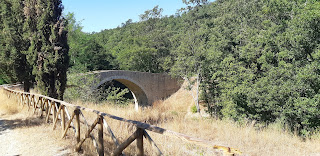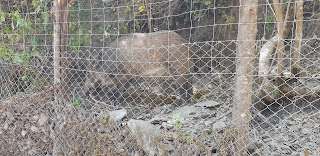This past Sunday, Michael and I took advantage of an outing proposed by one of the local historical societies here. The plan was to walk along what are thought to be the vestiges of the Via Amerina, admiring the medieval and in some cases Roman architecture along the way. Following our perambulations, we would lunch together at a local agriturismo heretofore unvisited by us.
Meeting at 7:30, we started off. Our guide explained to us that at a certain period in Roman history, the Empire held essentially only the wide area around Rome and Ravenna (to the north, direction Venice). To get from Rome to Ravenna, however, meant staying within a rather narrow corridor; on either side were to be found hostile forces. The Via Amerina was the road in the center of that narrow tract. While it is still easily visible south of Narni, the northern reaches within Umbria are less distinct and more open to interpretation based on geography and landmarks. It appears as though it was not paved with the huge stones used elsewhere, or perhaps the stones were taken in later times for building.
 |
| The first mill we came to: the owner was able to make enough money to purchase houses for each of his ten children back in the 1950s |
 |
| First mills, abandoned since the 1970s |
 |
| First mill, entrance. |
This first mill was not properly part of the Via Amerina, but rather was located on the Arnita. We had to follow a little woodland path to meet up with the Amerina.
 |
| Having walked in the woods for a bit, we emerged onto a path skirting a field. Fiore is in the distant left. |
 |
| Everyone was ragging on my beloved castle. From what I gathered, the crenellations may have been added later? Anyway, since it's not like the local architecture, they don't it. |
 |
| This is how the path looked for most of the way |
 |
| This is a huge new wannabe agriturismo that fell on hard times in the pandemic. It hasn't yet been finished, yet all the copper downspouts have been stolen. |
 |
| Now attached to the large building above, this was a chapel associated with the "ospedale" |
 |
| First bridge! Certainly rebuilt since Roman times based on the masonry work |
 |
| The Arnita runs mostly dry in summer |
 |
| I found the geology intriguing |
 |
| Second mill! We couldn't get closer because the road deviated from the river and it was private property. |
 |
| Ponte Romana, most certainly rebuilt in the medieval and recently repointed. |
 |
| Third mill, purportedly privately owned as a summer house. |
 |
| Third mill, from the other side. |
 |
| Ponte Falce, "Sickle Bridge" because of the curved path heading out of the "handle" provide by the bridge |
 |
| Ponte Falce from the side |
 |
| Wild boar! Actually somewhat protected by an agriturismo |
 |
| Such a sweet face! It was snuffling along rooting up plants. Yes, they're very destructive and can be extremely dangerous, particularly when they have young. |
I realize that I somewhat stupidly didn't take photos of the outside of the fourth mill. It is a working farmhouse, hardscrabble existence for sure. The owner was gracious enough to show us the workings of the mill, which has not been in use since the 1970s.
 |
| Christmas dinner |
 |
| The far left was for animal feed, the right (center) was for polenta |
 |
| Left (center in real life) was the polenta mill, right was for flour. There were levers underneath the various mills to divert the water flow and provide power to the particular mill. |
 |
| Scale for weighing bags |
 |
| Olive grinding |
 |
| The jute disks were used in olive pressing for filtration |
 |
| View from our (shaded) seats |
We had some of the best prosecco I've ever had, and several of our co-adventurers were also commenting on it. It didn't have a label on it, and was served out of completely plain glass bottles. Because of this, I asked the waiter about it and he said he'd let me know which winery it came from. Unfortunately, we all forgot before we left because we were stuffed with a delicious meal and in a food coma. I did send a message to Orietta, though, and she brought me four bottles to enjoy! Finally, I've found out which cantina it came from.













